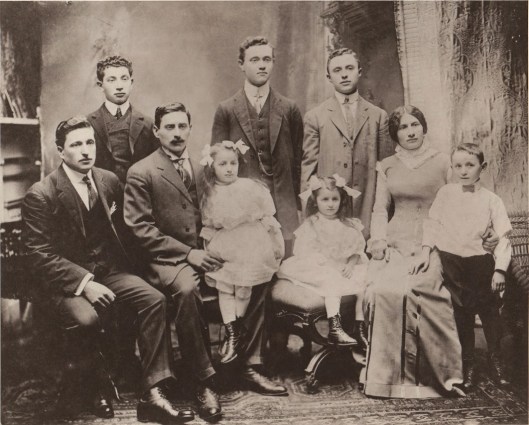Gazing at old photos, I imagine having conversations with my ancestors. Photos are deceptive that way. They appear so immediate, so full of meaning. And yet, these are relatives I never met. I don’t even know who they are. Take a look at this handsome fellow:

Mama called him “przystojniak,” “handsome guy.” But who is he?
When I showed this photograph to my mother in 2011, when she could only communicate in single words, she exclaimed, “przystojniak!” In Polish that means “handsome fellow,” or if I want to believe Google Translate, “hunk.” Mom would never have called someone a “hunk,” so I’m sticking with “handsome fellow.”
When I asked mom who the handsome guy was, though, she didn’t know.
I wonder if it might be one of her mother’s brothers, perhaps Abraham/Jon Piwko who came to the US long before mama was born. It would help if I could pinpoint the year in which the photo was taken. His clothes provide some hints–the short, wide tie, the jacket pocket, and the cuffed pants. Still, I don’t know enough about historical fashion to figure it out.
If this is Abraham, it was taken when he was young, maybe even before he left Poland in 1906. The carved stone bench looks more European than American, but who knows? It’s also striking that his feet are not on the ground, but rather on a round pillow. By 1908, when this photo was taken Abraham wore a mustache without a beard:

The Pifko brothers around 1908, New York. Front from left: Philip, Abraham, Paulina, Ewa, Bertha, Nathan. Back from left: Raphael Kolski, Sam and Max Alexander
Looking back and forth between the two photographs, I can’t tell if it’s the same person or not.
These photos were in the envelope my grandmother labelled “Do Not Open.” She didn’t want us to know about our family history because she didn’t want us to know our ancestors were Jewish.
One other photo in that envelope depicts a young girl. She stares at the camera with assurance, a charming smile revealing her dimples. Long curled locks reach down to her waist. She holds a telephone to her ear, tilting her head down toward the hand-held earpiece. A cousin has identified her as Abraham’s daughter Paulina Piwko, the older girl in the group photo above.

Again, clues to the date of the photo should be in the clothing–the white lace-up boots worn with knee-high stockings held up with garters, the pleated white dress reaching just above the knee, with a frilled collar and pleated short sleeves. Again, I don’t know enough to be able to read these clues and pinpoint the date the photo was taken. If this is Paulina, she would have been a little older than in the group photo. If she is 10 in this photo, it was taken around 1913.
My cousin Krysia has remarked on how much this looks like our grandmother. And I agree. Babcia also had dimples, thick, long hair, and the kind of charm that seems to radiate from the girl in the picture. If it were Babcia, that would mean this photo was taken around 1904. Candlestick phones like this were in use from around 1890-1940, so that clue doesn’t narrow things down enough to confirm or rule out either possibility.
Still, my cousin, a descendant of Abraham, knows this photo and recognized it as his great aunt Paulina. Why would he have seen a picture of my grandmother? Why would it have been among the photos that were passed down in his line?
Here’s a fantasy explanation–one I have no evidence for outside of the photographs themselves. Could the photos of the handsome fellow and the charming girl have been taken at the same time? Might the siblings have wanted photos of each other when the older brother went away the America, never to return? It’s a long shot, but it would make a good story.

your search is a delight to follow! Wiley would have thought so too! …and Wiley would have been amazed to see/read your imagination at work on these ancient photos…
as am I. love from Charlie (Oran) and God bless!
LikeLike
Thank you! I miss my Dad…
LikeLike